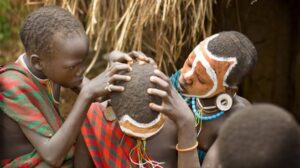The Dinka tribe, one of the largest ethnic groups in South Sudan, has a rich cultural heritage that includes various traditions, rituals, and practices. Among these traditions, scarification holds a significant place, serving as both a cultural marker and a symbol of beauty within the community. In this comprehensive guide, we delve into the history, significance, and techniques of scarification among the Dinka people.
History and Cultural Significance
Scarification has deep roots in Dinka culture and dates back centuries. It is an ancient practice that predates written history and has been passed down through generations as a cherished tradition. For the Dinka, scarification serves multiple purposes, including cultural identification, rites of passage, and aesthetic enhancement.
Cultural Identification
Scarification plays a crucial role in identifying individuals within the Dinka tribe. Different patterns of scars signify various aspects of identity, such as clan affiliation, social status, and age group. These scars serve as permanent markers that distinguish one member of the community from another, fostering a sense of belonging and unity among the tribe.
Rites of Passage
Scarification is often performed during important rites of passage, marking significant milestones in an individual’s life. For example, young Dinka boys and girls may undergo scarification rituals as they transition into adulthood. These rituals symbolize maturity, courage, and readiness to take on adult responsibilities within the community.
Also, read; Nigeria’s Barau Jibrin Named Acting Speaker of ECOWAS Parliament
Aesthetic Enhancement
In addition to its cultural and symbolic significance, scarification is also valued for its aesthetic appeal. The intricate patterns and designs created through scarification are considered beautiful and desirable within Dinka society. Adorned with these scars, individuals are seen as more attractive and desirable mates, enhancing their social standing and prestige within the community.
Techniques of Scarification
The process of scarification among the Dinka involves using sharp objects, such as knives or razor blades, to create cuts or incisions on the skin. These cuts are then rubbed with charcoal or ash to promote healing and the formation of raised scars. The patterns and designs vary widely, ranging from simple lines and dots to more elaborate motifs inspired by nature, animals, or tribal symbols.
Conclusion
Scarification remains a deeply ingrained cultural practice among the Dinka tribe, serving as a tangible link to their rich heritage and identity. While scarification may be viewed differently in modern society, for the Dinka people, it remains a cherished tradition that embodies their values, beliefs, and sense of community. As we continue to explore and appreciate the diverse cultural practices of indigenous peoples around the world, scarification among the Dinka tribe stands as a testament to the enduring beauty and resilience of traditional customs.

